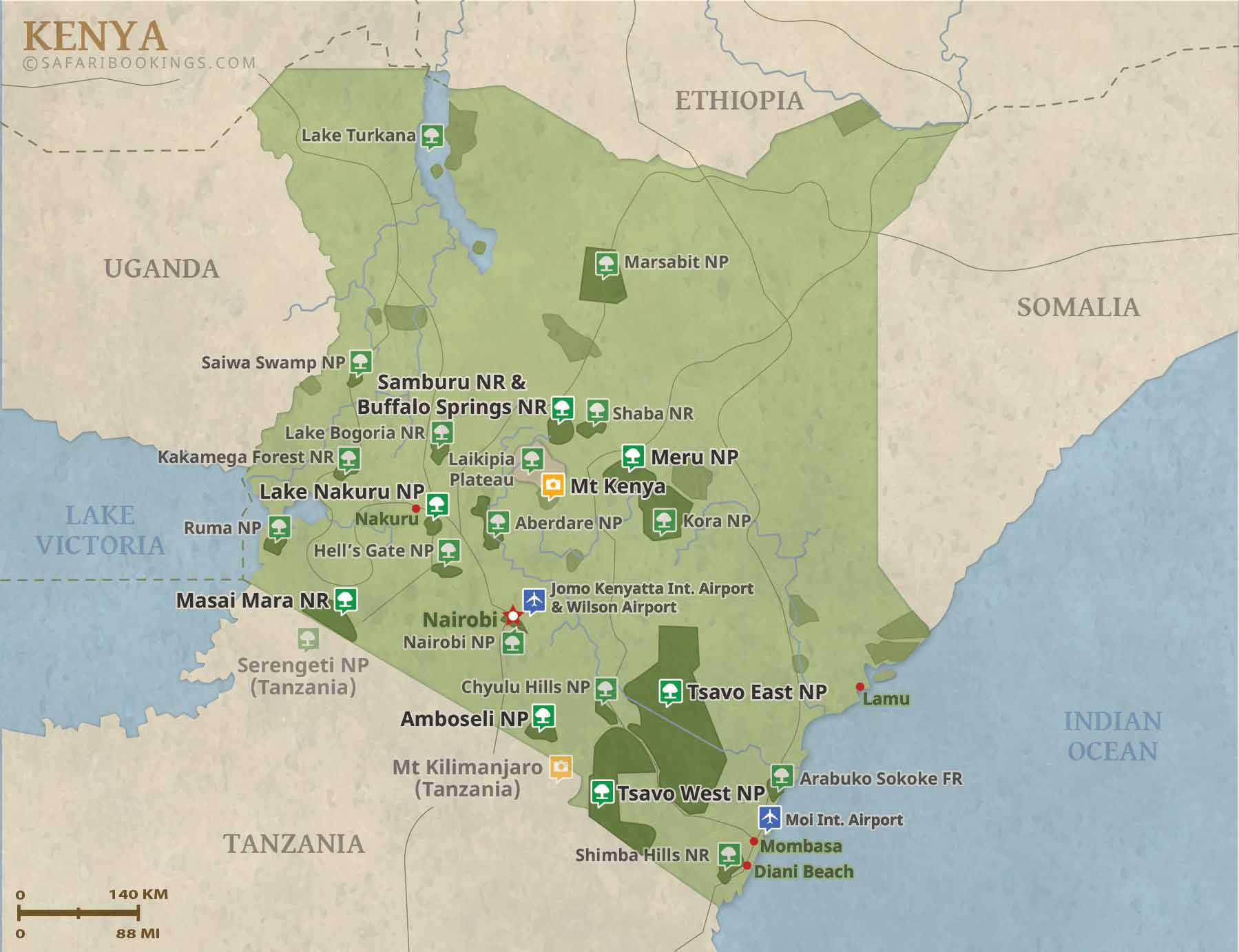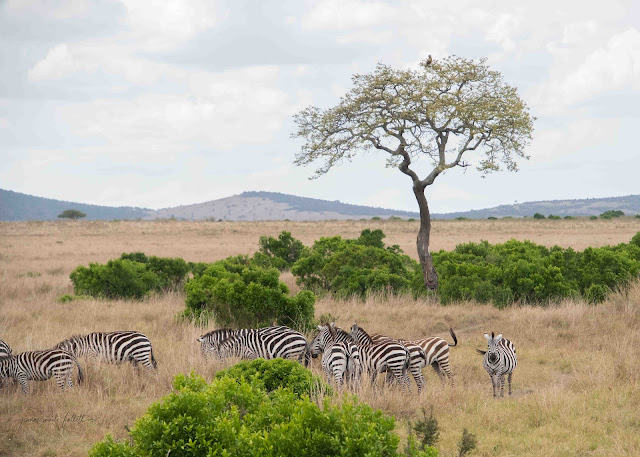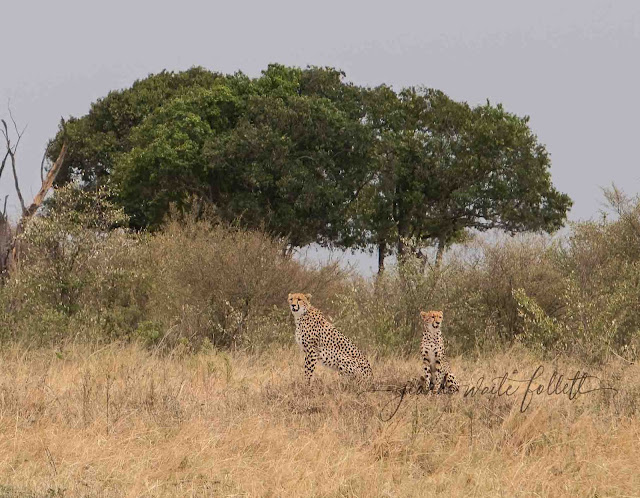Chapter 19:
There are Game Drives and then there are GAME DRIVES!
"But African time was not the same as American time…As African time passed, I surmised that the pace of Western countries was insane, that the speed of modern technology accomplished nothing, and that because Africa was going its own way at its own pace for its own reasons, it was a refuge and a resting place.”-Paul Theroux
We landed at Keekorok airstrip around 11 A.M. and walked into the welcoming arms of our African guides. It felt like we were being welcomed home, even this is only my second time lodging at Enkewa camp.
| Keekorok is located near where all the roads come together in the lower right. Enkewa camp is in the area southwest of the airstrip. The guys load all our luggage except cameras into one vehicle and it heads immediately to camp. The camp Land Rovers appear to be brand new and I recall the owner, Jose, telling us he had ordered new vehicles just before the COVID pandemic hit and closed down so many camps in Kenya. I climb into a three-row truck with Peter driving and I expect he will follow the luggage truck. Pretty soon I realize we aren't passing any familiar landmarks. We are also on a Ferrari Safari, which is what we call driving far too fast for scanning the landscape for animals Peter has the two-way radio on high volume. This is unusual because almost all the guides are now using cell phones for communicating privately with each other. I lean back, hold on, and imagine that Peter is a young man with his first hot car and loud radio blasting across the savannah. I'm not far off. We come upon a herd of zebras and wildebeest and Peter slows down to let the animals cross the track. First stop: some beautiful Coke's hartebeest, so-called because the shape of their horns resembles a heart. A large antelope at 46 inches at the shoulder, these animals weigh a little over 300 lbs. They prefer dry savannah and forested woodlands, and will often move to more arid regions after rainfalls. They have been spotted at the 13,000 ft. elevation on Mt. Kenya. Hartebeest share similar traits with wildebeest, topi, and blesbok in that they have elongated heads with forequarter sloping to hind quarters. There are several varieties of hartebeest, with a couple having become extinct. Next, I ask Peter to stop ("Oh, look! A calf!") so we can photograph two eland with a calf. Can't miss calves, no matter what species. The common eland is the largest antelope at up to 6 ft. at the shoulder and males weighing up to 2200 lbs. While they are the slowest antelope at 25 mph, they can jump 10 feet from a standing start. Males have a large dewlap and are really impressive animals. This is an interesting item from Seaword.com: When walking, tendon or joints in the eland's foreleg produce a sharp clicking sound, the cause of which has not been widely investigated. The sound carries some distance and is a good indication of an approaching herd. Some scientists believe it may be a form of communication; if a male is walking through his territory, the clicking which can be heard for up to a mile away, may alert another eland about this territory. We leave the elands and soon slow again for a herd of zebra and wildebeest. The zebra are blocking the track, so Peter moves forward slowly. Then, the reason for the rush appears. A leopard was spotted earlier and the guides are taking us to see it. I laugh to myself at something Marg said a few years ago: "These guys are hard-wired to find leopards." She and I were once lined up to take photos of elephants against the horizon at sunset. Suddenly the guide yelled at us to get back in the truck. Then they raced down into a gully--and there was a famous female leopard known as Fig, who was walking through a scrum of safari vehicles. It was too dark for photos. We missed the elephants on the horizon. Our first look at this leopard. She moves into a ditch where she is partially concealed and carefully scans for game. Then she moves back into the depression and walks along it, closer to the main herd. |
 |
| Leopards are beautiful and impressive cats. |
Leopards are about 6 feet in length and females weigh up to 88 lbs, with males weighing 130 lbs. They are powerfully built cats that can carry their prey up a tree to protect ion from other animals that might steal it.
Leopards are primarily nocturnal so seeing one out in the daylight at noon is exceptional. No wonder we were in such a rush.
It is remarkable how close the herd animals are as the leopard watches for the right one--a calf, or a sick or wounded animal. Some even wander closer to her, apparently unaware of her presence.
Apparently she doesn't see a likely catch, so she lies down in the grass. That's where we leave her to continue our drive.
Fifteen minutes later, the guides find two female cheetahs roaming through the grasslands and brush. They are sisters, out one their own though they still have mantles on the back of their necks. A mantle is a long patch of hair that helps camouflage cheetah cubs.
Cheetahs have long bodies--four feet plus another two or three feet of tail. They weigh from 75 to 120 lbs.
Their sprint speed has been measured at 71 mph, though they can exceed that when pursuing game.
When big cats are spoken of, cheetahs are generally included. Some internet sites claim that they aren't true cats because they can't roar.
A video for you. Our guide, Dominick, suggested the names Napi (Brave) and Nanyorri (Beloved). The names were adopted. This was a first sighting of these two out on their own.
It's a video! Play it!
Some information from Britannica on what makes cheetahs are so special:
Cheetahs have evolved many adaptations that enhance their ability to sprint. Their legs are proportionally longer than those of other big cats; an elongated spine increases stride length at high speeds; they have unretractable claws, special paw pads for extra traction, and a long tail for balance. Internally, the liver, adrenal glands, lungs, bronchi, nasal passages, and heart are all large to allow intense physiological activity. During a chase, cheetahs take about 31/2 strides per second and 60 to 150 breaths per minute.
We spend a lot of time with the cheetah sisters and leave when they seem to be ready for a nap.
We are heading in the direction of camp now and come across some elephants with very young calves.
 |
| This calf is so young you wonder how it can reach high enough to suckle. |
Finally I recognize the scenery and realize we are close to "home."
But, before we get there, we see the third and last members of the Big Cats of Africa-- lioness with her two cubs.
All three of the Big Cats in one drive--leopard, cheetahs, and lions! And we haven't even reached camp from the airstrip.. Phenomenal!
KUDOS to our guides!!!
Can't forget the jackal pup we see.
And then, we roll into camp. Happy with the drive, happy with the camp and happy, happy with lunch that featured broiled chicken and salad, topped off my personal favorite--the Chocolate Amarula Mug.
 |
| The Maasai Mara National Reserve, where we are now, is the tiny dark green spot at left, on the border with Tanzania. It covers 580 square miles. It is unfenced and conservancies along its upper borders increase the habitat for animals. |
| This map shows Kenya on the east coast of the continent at the equator. |
































Another WOW .. that was some safari drive from the airport to your camp! First you saw all the animals your driver simply slowed down for to let get across the track. THEN came the elegant leopard, the cheetah sisters with the one looking to be in complete ecstasy at being groomed by her sister, next the wee baby elephant who could barely reach high enough to suckle, followed by the lioness and her two cubs. Thank GOODNESS when your luggage was loaded to be taken directly to camp, you all kept your cameras. What a camera shoot !!! Welcome home is right !!! Smiling, as we an only assume you were. Patti and Cap
ReplyDeleteWow!! Big cats galore! Love those cheetah sisters. And then baby elephants. And toss in lion cubs. What an opening for this camp. And I think when we head to Denali Highway in June you need to make me a chocolate amurala mug!! Sounds delicious!
ReplyDeleteLeilani
What a trip. Now that you saw all the animals just getting to camp, you can relax and enjoy the camp for a couple of days(NOT).
ReplyDelete